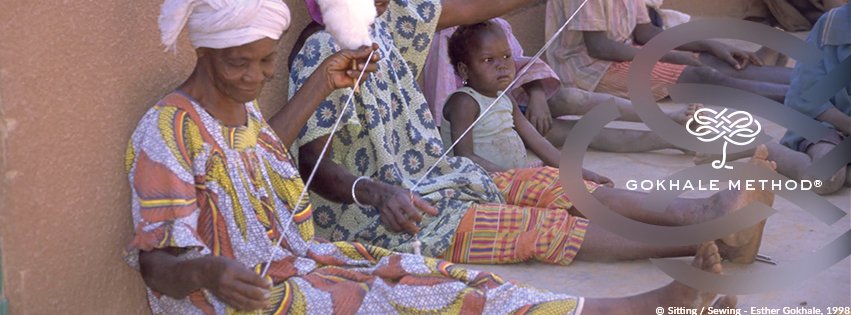August is peak holiday time across the northern hemisphere, and many of us who live here will find ourselves poolside, or even better, in it!
Being in water has the natural advantage of lifting weight off the joints while providing gentle resistance training. Aching backs or knees can find relief from compression in the natural buoyancy that water provides. This has made pool exercises a popular prescription with physical therapists over many years, especially for post-operative or post-injury rehabilitation.
On land, to relieve pain and compression, people usually use elaborate measures like inversion tables, traction units, or going to outer space! In the Gokhale Method we provide decompression for the lower back relatively simply with the Stretchsit® Cushion or the nubs on our Gokhale™Pain-Free Chair. But stepping into water is the simplest of all, giving you freedom of movement and the ability to strengthen yourself simultaneously.
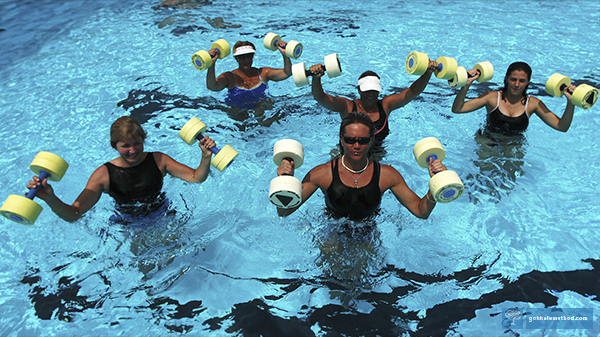
Pool exercise also provides a fun and refreshing environment for exercise in summer heat waves! Wikimedia
This blog post gives you three ways to harness the unique benefits of being in water to practice and develop healthier posture. These exercises are challenging enough to do as a stand-alone workout or as a way to prime your swim session.
Healthy posture habits honed in water will benefit your daily life on land, as well as giving you greater stability and power for your swimming or other sports.
For safety and best results, I recommend that you progress the session in the order given here, starting with Exercise 1 and, once you are familiar with it, move on to Exercise 2 and finally add Exercise 3.
1. Stabilize your spine by using your inner corset
You will use a natural brace of muscles as you walk across the pool. It will give you the stability you need to cut through the resistance of the water without wobbling and threatening the alignment of your spine.
Imagine you are getting into ice cold water. Feel how all the muscles around your middle can contract and make you more slender. You want to work hard enough to feel this from deep in the pelvis all the way up to your rib cage. You want to feel the muscular engagement all the way around your mid torso, like a tightly laced corset.
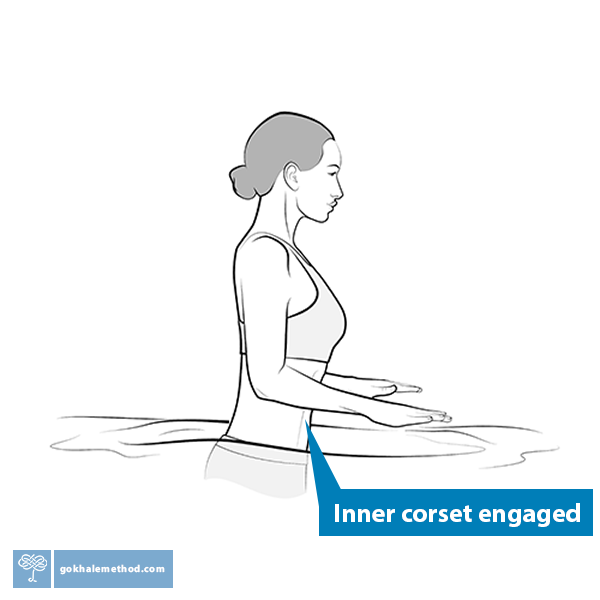
The muscles of the inner corset include the deep intrinsic back muscles, the abdominis transversus, and the obliques.
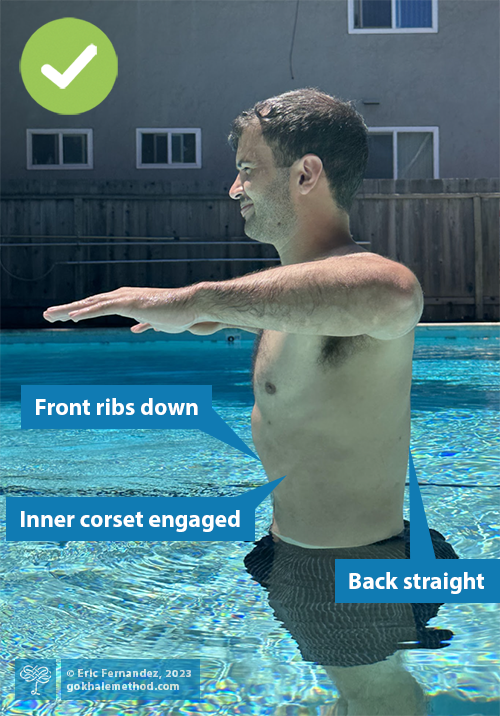
Gokhale Method teacher Eric Fernandez shows how engaging the inner corset draws the abdomen in and makes the torso slender.
This is one way of recruiting your “inner corset," which will help stabilize your spine as you walk and is key to swimming with a more streamlined, efficient stroke. We teach this technique and others in more detail in our in-person Foundations course, one-day Pop-up course, our online Elements course, plus our Gokhale Exercise program. You can read more about your inner corset here.
2. Headload to lengthen your neck and to find deep spinal support
In industrialized cultures we have an epidemic of forward head carriage, putting enormous strain on the neck and structures throughout the back. Finding healthy alignment through your neck, combined with the inner corset, helps your whole spine to support itself well. Resting even a modest additional weight on the head can help us to find our vertical axis and stand tall. This is the reason I developed the Gokhale™ Head Cushion.
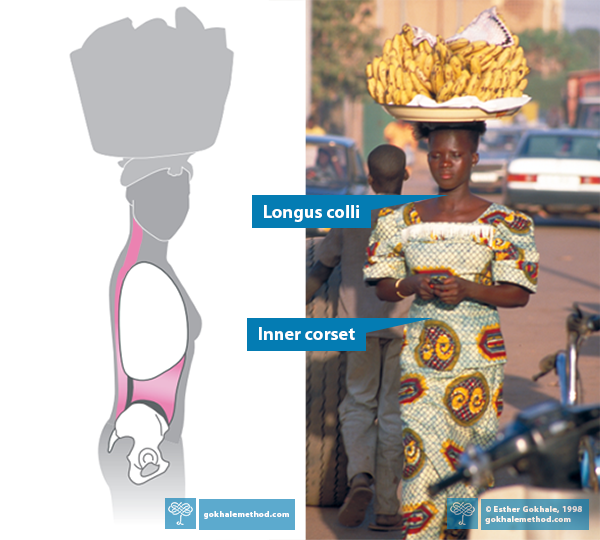
Headloading encourages recruitment of the deepest muscles of the inner corset and the neck, especially the longus colli at the front of the spine.
In the pool I suggest you use what you have at hand—your hands! Rest them on your head and push up against them with your head. Keep your nose and chin angled downward. Proceed very gently if you have neck issues. You can gradually build up the intensity over a number of sessions.
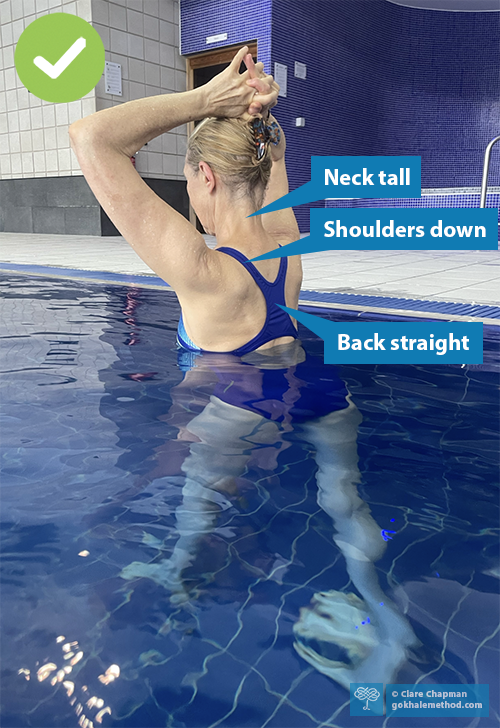
Gokhale Method teacher Clare Chapman headloading in the pool using the weight of hands and arms. Create space between your shoulders and your ears—keep your shoulders down as your neck grows tall.
Establishing healthy length in your neck will help you to retain a straighter, more spacious alignment while swimming, especially in breaststroke where people tend to crane their necks to hold their heads above water. Consider training to swim with your head in the water, if you do not do this already, which will enable a much healthier alignment of your torso, neck, and head.
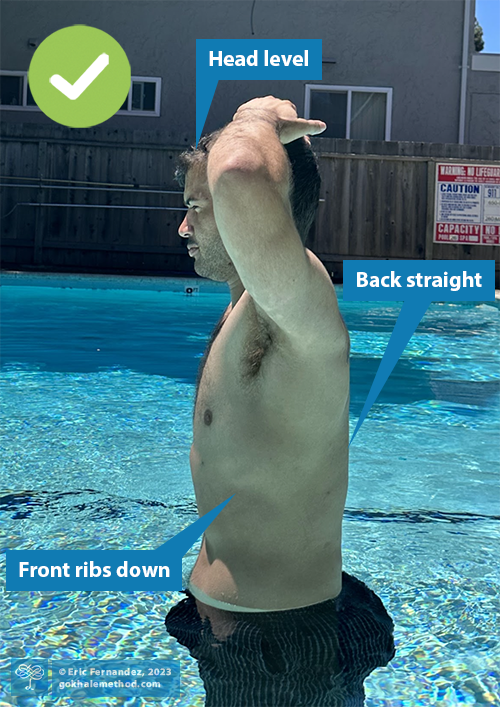
Especially when you raise your arms, you may need to use your rib anchor muscles to prevent your back from swaying.
3. Power up your walking using your feet and glutes
Many of us compromise our walking by overusing our quads and hip flexors (psoas muscle) and underusing our glutes. We predominantly reach our front leg forward in our strides, instead of generating propulsion from the rear leg with our glutes and foot muscles.
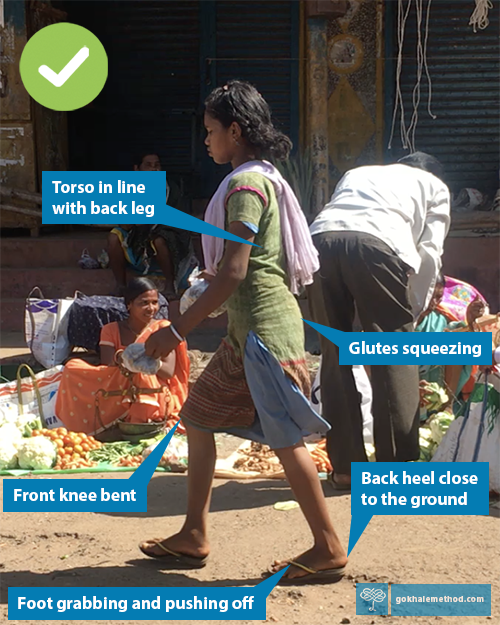
Our ancestors and many people living in more traditional or nonindustrialized societies—where joint and back pain are rare—walk using their glute and foot muscles more than we typically do.
As you walk in the pool, make each step a rep. Each step wants to progress through a pose that includes a straight back leg and a bent front knee. As each leg goes back behind you in turn, squeeze your buttock muscles on that side. Engage the upper outer quadrant of your glute pack. This is not the kind of glute squeeze that clenches your lower butt cheeks together and tucks your pelvis.
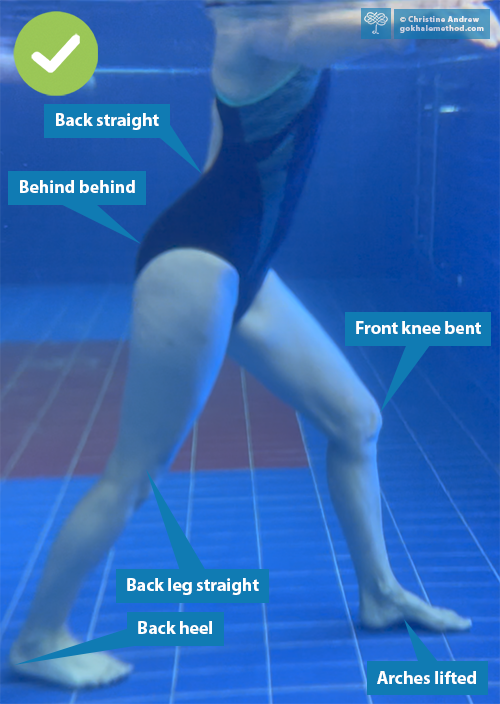
Gokhale Method Alumna Christine Andrew working hard to achieve healthy walking form in the buoyancy and resistance of water.
Grab the floor of the pool with the whole sole of your foot, and then push off from your toes. Focus on maintaining the convex foot shape as you do this. Propel to glide forward, not bounce upward.

Eric actively grabs the floor of the pool with each foot to pull the body forward and then push back.
Putting it all together: Aim to keep healthy form and walk as smoothly as you can through the water. This develops both healthy length and muscle power in the right places.
If you notice your back arches back as you walk, take smaller steps and lean more forward until you master the art of keeping your spine stable with the rib anchor and inner corset techniques. Enjoy!
Best next action steps for newcomers
If you would like to know which posture changes will help you be pain-free and functional, schedule an Initial Consultation, online, or in person.
You can sign up below to join one of our upcoming FREE Online Workshops. . .


